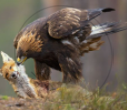Advertisements
Advertisements
प्रश्न
In a pond, we see plants which are free-floating; rooted–submerged; rooted emergent; rooted with floating leaves; Write the type of plant against the following examples.
| Plant Name | Type | |
| a. | Hydrilla | ______ |
| b. | Typha | ______ |
| c. | Nymphaea | ______ |
| d. | Lemna | ______ |
| e. | Vallisneria | ______ |
उत्तर
| Plant Name | Type | |
| a. | Hydrilla | Submerged |
| b. | Typha | Rooted emergent |
| c. | Nymphaea | Rooted with floating leaves |
| d. | Lemna | free – floating |
| e. | Vallisneria | Rooted Submerged |
APPEARS IN
संबंधित प्रश्न
Give the role of VAM related to soil fertility.
What is the ecological principle behind the biological control method of managing with pest insects?
Association between sea anemone and Hermit crab in gastropod shell is that of.
In Logistic growth curve lag phase shows______.
Define Absolute Mortality.
The interaction in nature, where one gets to benefit on the expense of other is _________.
Identify the interspecific interaction depicted in the following figure.

Define ectoparasite and endoparasite and give suitable examples.
Lianas are vascular plants rooted in the ground and maintain erectness of their stem by making use of other trees for support. They do not maintain direct relation with those trees. Discuss the type of association the lianas have with the trees.
Pick out the appropriate association representing brood parasitism.
